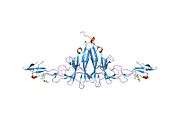BTLA
| BTLA | |||||||||||||||
|---|---|---|---|---|---|---|---|---|---|---|---|---|---|---|---|
 |
|||||||||||||||
| |||||||||||||||
| Identifiers | |||||||||||||||
| Aliases | BTLA, BTLA1, CD272, B and T lymphocyte associated | ||||||||||||||
| External IDs | MGI: 2658978 HomoloGene: 52233 GeneCards: BTLA | ||||||||||||||
| Orthologs | |||||||||||||||
| Species | Human | Mouse | |||||||||||||
| Entrez | |||||||||||||||
| Ensembl | |||||||||||||||
| UniProt | |||||||||||||||
| RefSeq (mRNA) | |||||||||||||||
| RefSeq (protein) | |||||||||||||||
| Location (UCSC) | Chr 3: 112.46 – 112.5 Mb | Chr 16: 45.22 – 45.25 Mb | |||||||||||||
| PubMed search | [1] | [2] | |||||||||||||
| Wikidata | |||||||||||||||
| View/Edit Human | View/Edit Mouse |
B- and T-lymphocyte attenuator is a protein that in humans is encoded by the BTLA gene.[3][4] BTLA has also been designated as CD272 (cluster of differentiation 272).
Function
BTLA expression is induced during activation of T cells, and BTLA remains expressed on Th1 cells but not Th2 cells. Like PD1 and CTLA4, BTLA interacts with a B7 homolog, B7H4.[4] However, unlike PD-1 and CTLA-4, BTLA displays T-Cell inhibition via interaction with tumor necrosis family receptors (TNF-R), not just the B7 family of cell surface receptors. BTLA is a ligand for tumour necrosis factor (receptor) superfamily, member 14 (TNFRSF14), also known as herpes virus entry mediator (HVEM). BTLA-HVEM complexes negatively regulate T-cell immune responses.
Clinical significance
BTLA activation inhibits the function of human CD8+ cancer-specific T cells.[5]
References
- ↑ "Human PubMed Reference:".
- ↑ "Mouse PubMed Reference:".
- ↑ Watanabe N, Gavrieli M, Sedy JR, Yang J, Fallarino F, Loftin SK, Hurchla MA, Zimmerman N, Sim J, Zang X, Murphy TL, Russell JH, Allison JP, Murphy KM (Jun 2003). "BTLA is a lymphocyte inhibitory receptor with similarities to CTLA-4 and PD-1". Nat Immunol. 4 (7): 670–9. doi:10.1038/ni944. PMID 12796776.
- 1 2 "Entrez Gene: BTLA B and T lymphocyte associated".
- ↑ Derré L, Rivals J-P, Jandus C, Pastor S, Rimoldi D, Romero P, Michielin O, Olive D, Speiser DE (2009). "BTLA mediates inhibition of human tumor-specific CD8+ T cells that can be partially reversed by vaccination". J Clin Invest. 120 (1): 157–67. doi:10.1172/JCI40070. PMC 2799219
 . PMID 20038811. Lay summary – Genetic Engineering & Biotechnology News.
. PMID 20038811. Lay summary – Genetic Engineering & Biotechnology News.
Further reading
- Pao LI, Bedzyk WD, Persin C, Cambier JC (1997). "Molecular targets of CD45 in B cell antigen receptor signal transduction". J. Immunol. 158 (3): 1116–24. PMID 9013950.
- Pao LI, Cambier JC (1997). "Syk, but not Lyn, recruitment to B cell antigen receptor and activation following stimulation of CD45- B cells". J. Immunol. 158 (6): 2663–9. PMID 9058799.
- Vilen BJ, Famiglietti SJ, Carbone AM, et al. (1997). "B cell antigen receptor desensitization: disruption of receptor coupling to tyrosine kinase activation". J. Immunol. 159 (1): 231–43. PMID 9200459.
- Dias Neto E, Correa RG, Verjovski-Almeida S, et al. (2000). "Shotgun sequencing of the human transcriptome with ORF expressed sequence tags". Proc. Natl. Acad. Sci. U.S.A. 97 (7): 3491–6. doi:10.1073/pnas.97.7.3491. PMC 16267
 . PMID 10737800.
. PMID 10737800. - Strausberg RL, Feingold EA, Grouse LH, et al. (2003). "Generation and initial analysis of more than 15,000 full-length human and mouse cDNA sequences". Proc. Natl. Acad. Sci. U.S.A. 99 (26): 16899–903. doi:10.1073/pnas.242603899. PMC 139241
 . PMID 12477932.
. PMID 12477932. - Gavrieli M, Watanabe N, Loftin SK, et al. (2004). "Characterization of phosphotyrosine binding motifs in the cytoplasmic domain of B and T lymphocyte attenuator required for association with protein tyrosine phosphatases SHP-1 and SHP-2". Biochem. Biophys. Res. Commun. 312 (4): 1236–43. doi:10.1016/j.bbrc.2003.11.070. PMID 14652006.
- Ota T, Suzuki Y, Nishikawa T, et al. (2004). "Complete sequencing and characterization of 21,243 full-length human cDNAs". Nat. Genet. 36 (1): 40–5. doi:10.1038/ng1285. PMID 14702039.
- Gerhard DS, Wagner L, Feingold EA, et al. (2004). "The Status, Quality, and Expansion of the NIH Full-Length cDNA Project: The Mammalian Gene Collection (MGC)". Genome Res. 14 (10B): 2121–7. doi:10.1101/gr.2596504. PMC 528928
 . PMID 15489334.
. PMID 15489334. - Sedy JR, Gavrieli M, Potter KG, et al. (2005). "B and T lymphocyte attenuator regulates T cell activation through interaction with herpesvirus entry mediator". Nat. Immunol. 6 (1): 90–8. doi:10.1038/ni1144. PMID 15568026.
- Gonzalez LC, Loyet KM, Calemine-Fenaux J, et al. (2005). "A coreceptor interaction between the CD28 and TNF receptor family members B and T lymphocyte attenuator and herpesvirus entry mediator". Proc. Natl. Acad. Sci. U.S.A. 102 (4): 1116–21. doi:10.1073/pnas.0409071102. PMC 544343
 . PMID 15647361.
. PMID 15647361. - Cheung TC, Humphreys IR, Potter KG, et al. (2005). "Evolutionarily divergent herpesviruses modulate T cell activation by targeting the herpesvirus entry mediator cosignaling pathway". Proc. Natl. Acad. Sci. U.S.A. 102 (37): 13218–23. doi:10.1073/pnas.0506172102. PMC 1201609
 . PMID 16131544.
. PMID 16131544. - Compaan DM, Gonzalez LC, Tom I, et al. (2006). "Attenuating lymphocyte activity: the crystal structure of the BTLA-HVEM complex". J. Biol. Chem. 280 (47): 39553–61. doi:10.1074/jbc.M507629200. PMID 16169851.
- Otsuki N, Kamimura Y, Hashiguchi M, Azuma M (2006). "Expression and function of the B and T lymphocyte attenuator (BTLA/CD272) on human T cells". Biochem. Biophys. Res. Commun. 344 (4): 1121–7. doi:10.1016/j.bbrc.2006.03.242. PMID 16643847.
- Wang XF, Chen YJ, Wang Q, et al. (2007). "Distinct expression and inhibitory function of B and T lymphocyte attenuator on human T cells". Tissue Antigens. 69 (2): 145–53. doi:10.1111/j.1399-0039.2006.00710.x. PMID 17257317.
External links
- BTLA protein, human at the US National Library of Medicine Medical Subject Headings (MeSH)
This article incorporates text from the United States National Library of Medicine, which is in the public domain.
